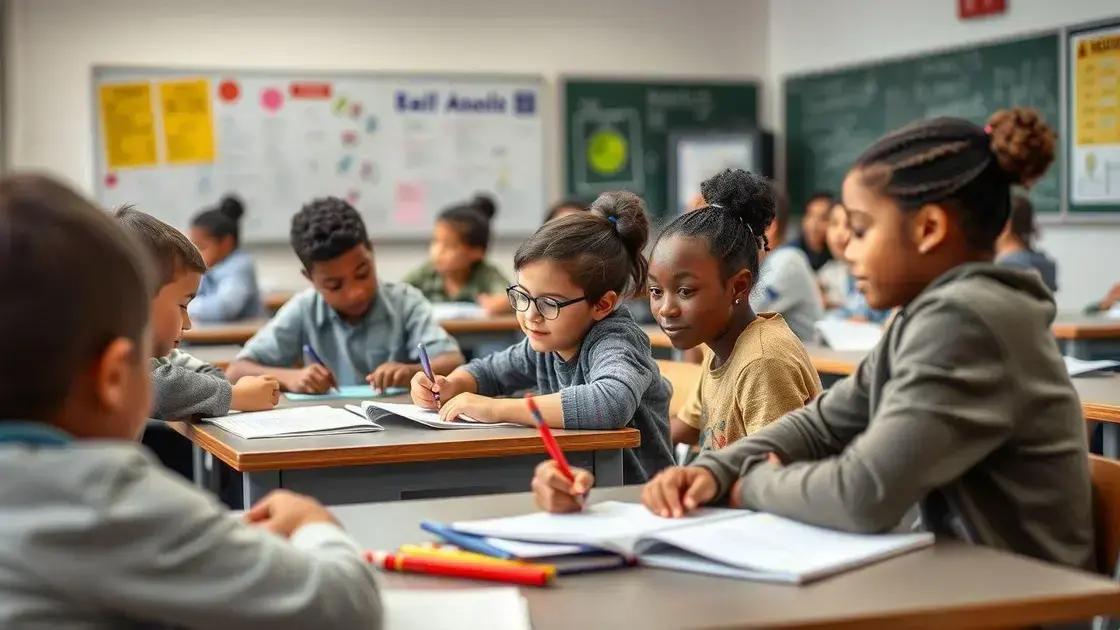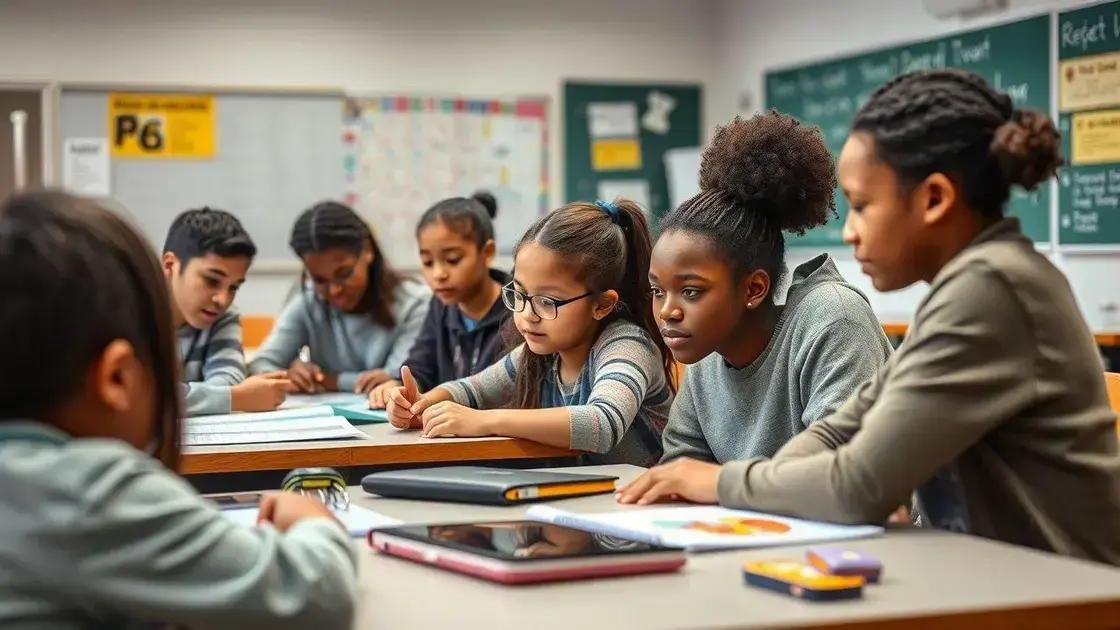K-12 education: Discover the benefits for every child

Anúncios
K-12 education focuses on providing a comprehensive learning experience for students from kindergarten through 12th grade, emphasizing academic skills, social-emotional development, and the integration of technology in flexible learning environments.
K-12 education plays a crucial role in shaping young minds. It’s not just about academic knowledge but also personal growth. Have you ever wondered how these years influence a child’s future?
Anúncios
Understanding the K-12 education system
Understanding the K-12 education system is vital for parents, students, and educators. This system provides children with a structured way to learn essential skills and knowledge. It spans from kindergarten through 12th grade, offering a blend of academic and social development.
Key Components of the K-12 System
The K-12 system consists of various levels, each designed to cater to different age groups. Here’s a closer look:
Anúncios
- Elementary School: Focuses on foundational skills in reading, writing, and math.
- Middle School: Introduces subject-based learning and prepares students for high school.
- High School: Offers advanced courses and electives, guiding students toward college and careers.
Each level builds upon the previous one, ensuring a comprehensive educational experience. Schools employ different teaching methods to engage students and accommodate various learning styles.
The Importance of Curriculum
A strong curriculum is crucial in the K-12 education system. It outlines what students should learn at each grade level. Many states adopt Common Core Standards to maintain consistency across schools. These standards help educators plan lessons that are both rigorous and relevant.
Additionally, teachers use assessments to track students’ progress. This helps identify strengths and areas for improvement, allowing personalized learning opportunities. Parents can also play a role by supporting their children’s education through involvement in school activities and homework.
Understanding how the K-12 education system operates can empower families to make informed decisions. By being aware of the different stages and the curriculum, parents can help their children succeed.
Challenges and Opportunities
While the K-12 system offers many benefits, it also faces challenges. Funding disparities can lead to unequal educational opportunities. However, many schools are finding innovative ways to overcome these obstacles.
- Utilizing technology in classrooms.
- Implementing after-school programs.
- Creating community partnerships for resources.
These efforts aim to enhance the educational experience for all students, regardless of their background. Through collaboration and commitment, the K-12 education system continues to evolve.
Key benefits of K-12 education
The K-12 education system offers numerous benefits for children during their formative years. This structure not only prepares them academically but also fosters social skills and personal development.
Academic Readiness
A primary benefit of K-12 education is its focus on academic readiness. Students learn essential skills in various subjects, laying a strong foundation for future learning. This prepares them for college or career paths by equipping them with a diverse knowledge base.
- Critical Thinking: Encourages problem-solving and analytical skills.
- Literacy and Numeracy: Fundamental reading and math skills are prioritized.
- Subject Variety: Exposure to numerous subjects helps students discover their interests.
In elementary school, foundational skills are emphasized, while middle and high schools introduce more complex concepts, helping students to hone their skills based on their interests.
Social Development
The K-12 system also plays a vital role in social development. As children interact with peers, they learn valuable interpersonal skills. These interactions help them develop friendships and learn to navigate social situations.
Collaboration is a key aspect, especially in group projects. This not only enhances teamwork but also teaches students how to communicate effectively. A strong social network can support children throughout their lives, contributing to their overall well-being.
Participating in extracurricular activities, such as sports or clubs, can further enhance their social skills. These settings encourage students to engage in healthy competition and develop leadership qualities while pursuing their passions.
Emotional Growth
Beyond academics and social aspects, K-12 education promotes emotional growth. Schools provide a supportive environment where children can express their feelings and learn about empathy.
Teachers and counselors can offer guidance, helping students cope with challenges. This emotional support is crucial for building resilience and self-confidence. Learning to handle disappointment or stress in a school setting prepares them for similar situations in the future.
- Resilience: Facing challenges helps build perseverance.
- Self-Esteem: Achieving goals boosts confidence.
- Empathy: Understanding others’ feelings enhances emotional intelligence.
Through these experiences, students not only gain knowledge but also become well-rounded individuals ready to face the world.
Innovative teaching methods in K-12

Innovative teaching methods in K-12 education are changing the way students learn and engage in the classroom. These approaches aim to make learning more interactive and effective.
Project-Based Learning
One significant method is project-based learning. This approach involves students working on real-world projects over an extended period. It allows them to dive deeper into subjects while developing critical thinking and collaboration skills.
- Engagement: Students stay interested when working on relevant projects.
- Collaboration: Groups work together, enhancing teamwork skills.
- Real-World Applications: Learning becomes applicable to real-life situations.
Project-based learning fosters creativity, allowing students to express themselves while tackling complex problems.
Flipped Classroom
Another innovative method is the flipped classroom model. In this structure, traditional teaching is reversed. Students learn new content at home through videos and engage in hands-on activities during class.
This approach gives students more control over their learning pace. It allows teachers to support students directly and address specific needs during class time. The flipped classroom encourages active participation and deeper understanding of the subject.
Technology Integration
Integrating technology into the classroom is a vital part of modern teaching methods. Interactive tools and online resources can enhance learning experiences significantly.
Using software and applications, teachers can create interactive lessons that cater to different learning styles. These resources not only make learning fun but also prepare students for a technology-driven world.
Students can collaborate on projects with peers globally, widening their perspective and understanding of world cultures.
Personalized Learning
Personalized learning focuses on tailoring education to meet the individual needs of each student. This method acknowledges that every learner is unique and progresses at different rates.
- Adaptive Learning Technology: Software adjusts the difficulty based on student performance.
- Flexible Pacing: Students learn at their speed instead of a fixed schedule.
- Individualized Support: Teachers provide specific help as needed.
This approach helps increase student motivation and achievement, ensuring that each child reaches their potential.
Addressing challenges in K-12 education
Addressing challenges in K-12 education is essential for ensuring every student receives a quality education. Despite the many benefits of K-12 systems, several obstacles can hinder student success.
Funding Disparities
One major challenge is the disparity in funding across school districts. Public schools often rely heavily on local property taxes, which can lead to unequal resources. Schools in wealthier areas may have better facilities and technology compared to those in lower-income regions.
- Limited Resources: Some schools lack basic supplies and materials.
- Teacher Salaries: Lower funding can lead to decreased teacher compensation.
- Program Availability: Extracurricular and advanced programs may be cut in underfunded schools.
These disparities can affect student learning and engagement, leading to gaps in educational achievement.
Teacher Shortages
Another pressing issue is the shortage of qualified teachers. Many schools struggle to fill teaching positions, especially in critical areas like math and science. High teacher turnover can disrupt learning and affect classroom stability.
To help retain educators, schools are implementing mentorship programs and professional development opportunities. Supporting teachers helps them feel valued and committed to their students’ success.
Standardized Testing Pressure
The emphasis on standardized testing can create added pressure for both students and teachers. While assessments are necessary for evaluating progress, an overwhelming focus can lead to teaching to the test, rather than inspiring a love for learning.
- Stress and Anxiety: Testing can cause significant stress for students.
- Narrowing Curriculum: Less time is spent on important subjects not included in tests.
- Limited Critical Thinking: Focus on rote memorization may hinder creative problem-solving.
Finding a balance between assessment and meaningful learning experiences is critical for student development.
Socioeconomic Challenges
Many students face challenges outside of school that impact their ability to learn. Issues like poverty, food insecurity, and unstable home environments can greatly affect academic performance.
Schools are increasingly recognizing the importance of addressing these factors. Programs such as free meal services and mental health support can help alleviate some of these burdens. By focusing on the holistic well-being of students, schools can create a more conducive learning environment.
Future of K-12 education
The future of K-12 education is evolving rapidly as technology and society change. Innovations in teaching methods and educational tools are transforming how students learn and teachers instruct.
Emphasis on Technology
One significant trend is the integration of technology in the classroom. Schools are adopting various digital tools to enhance learning experiences. This includes interactive whiteboards, tablets, and educational apps.
- Personalized Learning: Technology allows for individualized learning plans that cater to each student’s needs.
- Remote Learning: Online platforms provide flexibility for students to learn from home, making education more accessible.
- Collaborative Tools: Students can collaborate on projects with peers globally, broadening their perspectives.
These advancements are making education more engaging and effective, preparing students for a tech-driven world.
Focus on Social-Emotional Learning
The future of education will also place a greater emphasis on social-emotional learning (SEL). Recognizing that emotional intelligence is crucial for overall success, schools are incorporating SEL into their curricula.
Programs that focus on empathy, teamwork, and emotional regulation help students develop essential life skills. Schools are looking to create supportive environments where students can thrive emotionally and academically.
More Flexible Learning Environments
Future classrooms are expected to become more adaptable. Traditional layouts are being replaced with flexible spaces that promote collaboration and creativity. Students will benefit from learning environments designed to accommodate various activities and teaching styles.
In addition to physical changes, the approach to learning is shifting. Schools are moving away from rigid schedules to more personalized, competency-based learning. This allows students to progress at their own pace, ensuring mastery of subjects.
Ultimately, these changes aim to create an education system that prepares students not only for academic success but also for life in a diverse and rapidly changing world.
FAQ – Frequently Asked Questions about K-12 Education
How is technology improving K-12 education?
Technology enhances learning by providing interactive tools and resources, allowing for personalized learning experiences.
What is social-emotional learning (SEL)?
SEL focuses on developing students’ emotional intelligence, helping them manage emotions, set goals, and build positive relationships.
Why are flexible learning environments important?
Flexible learning environments adapt to different teaching styles and student needs, which can lead to increased engagement and better academic outcomes.
How can parents support their child’s education?
Parents can support their child’s education by being involved in school activities, communicating with teachers, and encouraging a positive attitude towards learning.






